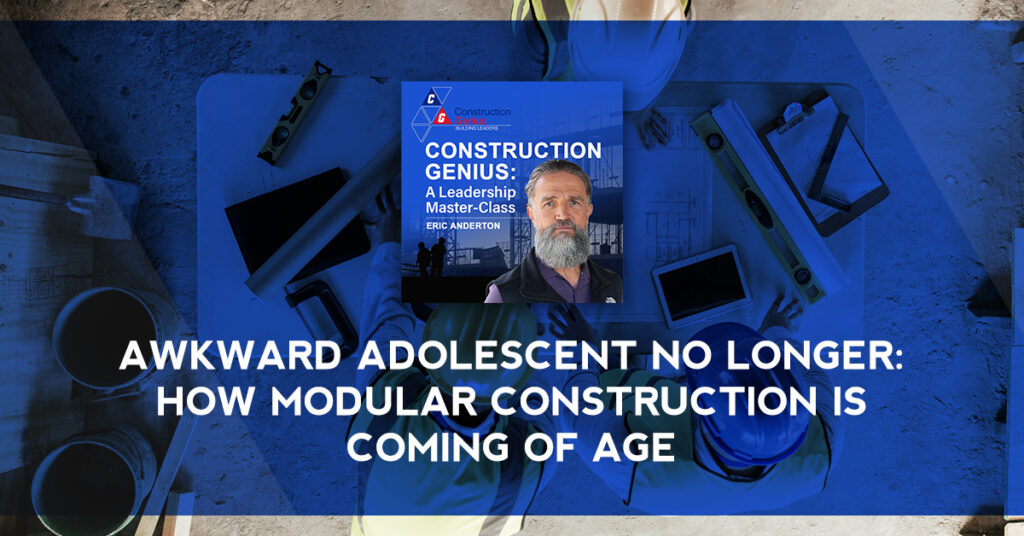The future of construction is modular, sustainable, and ready to evolve. Modular construction is transforming the way we build, addressing a housing deficit of over 7 million units with innovative solutions. In this episode, Roger Krulak, Founder and President of FullStack Modular, explores how modular construction is evolving into a mature player in the game. Throughout the episode, Roger takes us on a ride through the evolution of this approach, unpacks the necessity that fuels innovation, reveals how cultural openness and economic factors impact the acceptance of industrialized construction, and offers a peek of the future for industrialized construction. Join us in this discussion on the evolution of modular construction, debunking myths, embracing innovation, and shaping the future of buildings.
—
Watch the episode here
Listen to the podcast here
Awkward Adolescent No Longer: How Modular Construction Is Coming Of Age
For those older folks in the audience, The Breakfast Club, Pretty in Pink, Sixteen Candles, Stand By Me, and River’s Edge, what are those? They are all coming-of-age movies from the ‘80s. I’m sure there’s a bunch of them from the ‘90s and the Aughts as well. As a Gen X-er and a child of the ‘80s, those are the ones that I remember. Why are we talking about coming-of-age movies on the show? That’s because there’s another thing that’s coming of age, and that is modular construction or industrialized construction and my guest is Roger Krulak.
If you go way back in the day to Episode 34 of the show, over 200 episodes ago, Roger was on the show discussing the modular construction revolution. We are catching up to see how that revolution is progressing. He uses that coming-of-age analogy because it’s a very apt one. It’s one where we are no longer in the infancy of modular. We are not yet fully mature. There are many things that need to happen in the construction world for it to be fully embraced, but progress is being made. The adoption of industrialized construction processes is happening at a rapid clip and is more inevitable.
We are going to catch up with Roger, get the latest insights, and see how his company has changed and been growing. We will give you a few action items that you can quickly lay hold of to make sure that you are not on the bleeding edge but the leading edge of thinking about using modular construction in your organization. Enjoy my conversation with Roger. Share it with other people who you think would benefit from reading. Thank you for reading the show.
—
Roger, welcome to the show.
Thank you so much. It is good to see you.
I had you on the show way back in the day in 2019, hundreds of episodes ago. It’s great to have you back on. As we sit here in mid to late 2023, how would you describe the state of industrialized construction in the United States?
Industrialized construction is rapidly coming of age in the United States. The industry, meaning the construction industry and specifically the housing side of the construction industry. For our purposes, multifamily, the deficit is, at this point, given conventional construction unachievable. That means that collectively, we have to find other ways of meeting that need. The need, at least the numbers I saw, is north of seven million. Seven million is a big number. We don’t produce anywhere near that as a country.
Seven million housing units of some description or another.
Seven million of some sort are needed all over the country. You can pick the reason. There’s the affordable, which gets labeled every day. There are the workforce housing businesses, intel opening up factories in Ohio and Northern Oregon, electric boat opening, having 15,000 new employees, engineer-types in Connecticut, or damage from flooding. It goes on and on. If you look at it as a big swath as if you are a windshield wiper spreading across the United States and looking at all of the needs, they are collectively colossal and unachievable based on processes.
You used this phrase, coming of age. When I think of that, I think of a coming-of-age movie. You got this little kid that turns into a teenager and looks like maybe will be an adult. Are we saying that modular and industrialized construction is about a teenager?
As a metaphor, that’s pretty good. It is a maturing business. That’s probably the reason I used coming-of-age because I don’t think it is a mature business yet, but I do think it is maturing. If you look at standard business development knowledge, it is not mature but it is well past its inception point where you are a hockey stick growth maturity of players in the market and becoming a marketable industry product business.
What are some areas where industrialized construction and modular are coming-of-age that people may not be aware of that will help perhaps change their perspective on the processes and the industry and help them maybe adapt it a little bit more rapidly?
When you are doing development, there are several stakeholders. The stakeholders are the authority having jurisdiction locally, the developer himself, the banks, or whoever is providing debt financing, and the method in which the trade is associated with how you are going to build those projects. All of those stakeholders need to, at some level, buy into the way in which you are going to create that space that there is a market for that location, and so on and so forth. When we talked a few years ago, the industry was looking at modular construction as an anomaly rather than as an opportunity. That has shifted, and that’s what I mean by what I’m saying.
Why do you think that shift has occurred?
Necessity is the mother of invention, to coin a phrase. The need cannot be met with what we are doing. Our population is growing. We are a pretty wealthy country that doesn’t seem to be able to provide housing for a good portion of the people who live here. It’s the reason you need to find solutions.
Necessity is the mother of invention. Click To TweetAs you are looking at the marketplace at the moment, I know you are over on the East Coast but you are expanding to the West Coast, tell us a little bit about that expansion and the challenges associated with that.
It’s another marketplace. I have been playing on the East Coast market from development and construction for a number of years. The West Coast, like any other geography, runs a little differently. What I can say is the openness of the construction community on the West Coast and developers, for that matter, seems, at the moment, to be even more open than they are over here on the East Coast.
Why do you think that is?
Culturally, it’s a little more experimental in its general nature. I think that that’s the reason. I don’t know what else to chalk it up to. The other thing that is a driver is that construction costs in California, for instance, are significantly higher than they are. For San Francisco, they are significantly higher than they are in New York, which is hard to believe. As a result of that, the need to solve a significant deficit in cost versus value is one of the drivers. Generally, in my experience, they seem to be more open to invention or technology as a way of solving a problem.
What do you think is the biggest mistake that people make? I’m thinking from the developer’s point of view particularly, but you can include other folks. When they are looking at industrialized solutions in construction or modular, what’s the biggest mistake that people make?
The biggest mistake is that we often, as human beings and certainly as people of habit, fall into the same conventional process that we are used to doing. You always do what you have always done because you are pretty comfortable doing it. It’s that way with so many things in life. The industry is such a large industry. It is 13.5% of the world economy. In order to move that in a direction, it takes a lot of energy and forward effort.
In order to be effective in thinking about utilizing any form of industrialized construction modular. It needs to be explored very early in the process. You have a developer who says, “I want to build student housing in Santa Monica. Now, I need to talk to the person who owes the land, the developer, and a potential bank. I’m going to progress the process enough so that I can provide enough information to all of the stakeholders.” You have moved along a path and things start to develop. They seem to make sense. If you haven’t considered alternative methodologies of producing that, it’s getting harder. Oftentimes, because those stakeholders, early on, don’t consider the options, they end up doing what they have always done.
In setting up your factories, is there any major difference between the factory you have on the West Coast and the factory you have on the East Coast?
There are some similarities. The similarities are they are pretty large. They are almost 100,000 feet. We are collaborating and co-locating with some of our partners on the East Coast. We are tenants of one of the larger transportation companies on the East Coast of the United States. On the West Coast, we are co-located with our steel manufacturer. The economies of the process are incredibly valuable.
As space, the things we build are big. They are not rocket ship engines, but they have to be moved around in large spaces, so we always look for large spaces that have plenty of storage. Both of them have that and they are both on the water. You can potentially ship via boat and not worry so much about the cross-state permitting that has to happen. Those are the things that are the same. They are both located in areas that have a history of understanding manufacturing. The people available who do have that experience in both Connecticut and Oregon have a very long-standing history of manufacturing and understanding that goes into that.
In your factories, what parts of the project are you manufacturing and putting together?
We assemble the entire project. The structure of the mechanical, electrical, plumbing finishes, and even the hallway finishes or the façade are all part of our system. We don’t necessarily manufacture all of that in our factory. Some of it we do, and some of it we don’t. Depending on the project, the volume, and the complexity, we shift between make and buy, which is typical of manufacturing but not necessarily of construction. We can manufacture almost everything that goes into our buildings, but we do assemble everything that goes into the building. Give us a platform to sit on and everything above it is mods all the way to the roof.
Does that necessitate your MEP subs coming into the factory and working there? How do you handle that?
We are all FullStack employees. Everybody who works in the factory is a FullStack employee. We have no subs. We have material suppliers and manufacturers that work for us and with us, but in the factory, they are all employees of FullStack.
What about on the job site itself?
There you have a licensed trade for all of the major disciplines. You have a general contractor. That is generally somebody who’s organizing the installation of the mods and what we call mate line tied together of all of the pieces that are built in the factory.
You are not the general contractor on most of your projects.
We can be, but we are mostly not.
Is that a shift in your business or is that something you have always chosen to do?
We might change our minds, but we have decided we don’t want to be general contractors. It’s a very different business. We are doing 80% plus of the work in the factory. It’s a specialization that can provide value to the developer or end user. It’s a whole other set of requirements that we haven’t ventured into at this point.
In your business development processes, are you mainly selling to the developer or are you also cultivating relationships with the GCs and the subs?
Yes to all of those things although we are heading in the direction of being developers ourselves in collaboration with some of the developers that we have been speaking to. The interesting thing about residential development versus industrialized businesses is that residential development is as lumpy as the stock market and factories want to be busy all the time. Blending those two as an opportunity is probably one of the bigger challenges. The way that we are going to solve that is to develop for ourselves.

As you put on your future glasses, your future hat, or something like that, a few years from now, where do you think are we in terms of industrialized construction and the use of it, not only residential but perhaps more commercial applications?
The word modular industrialized construction is so all-encompassing. The volumetric modular construction that we do, and I have explained what that means, has lots of uses, but it also has a lot of things it doesn’t work so well for. The lots of uses are housing that is affordable, market-rate hotels, hospital beds, good parking lots or restaurants, and independent living facilities. All those things have potential.
There are other industrialized methodologies that work for commercial, tilt-up buildings, industrialized plants, and all those things. I have certainly no expertise in it. I have been around it for a long time. I believe that the market alone has room for a very large industry, which is still maturing. It’s one subject and one process. There is a whole lot of use.
—
I hope you are enjoying my discussion with Roger. It’s that time in the show when I do one of my exciting commercials for the one book every construction leader must read. That is Construction Genius. We have got 4.9% from 28 ratings. Here are some of those reviews, “Be inspired and elevated.” “Valuable insight for anyone in the construction business.” “Great read.” “A great book for any business owner and executive team.” “Practical, actionable advice.” “A must-read.” “A great training tool for your construction team.” There’s a variety of real-life people giving real-life reviews to the Construction Genius book. You can get a Kindle for $9.99, a hardcover for $29, and then a paperback for $20. Go out to Amazon and purchase yourself a copy. I know you won’t regret it. Let’s go back to the interview with Roger.
—
What is the biggest frustration that you have in terms of the work you do? What do you focus on in order to try and chip away at that frustration if it’s something that you control?
I wish I controlled everything. The question you are asking is what are the two biggest pain points? To me, there are two major pain points. One of them, you asked about and I have talked about a little bit. It is that once we build our mods and do 80% of the work, it has to be installed onsite. The cost of doing that has to be managed so that you give value to the end user, whether that be a developer or a customer. That’s still a pain point in this industry because that’s still young. It is even younger than the industry itself. The other is keeping a factory busy is what makes it make money and also makes it more efficient and cost-effective. The industries, even though the value proposition goes in both directions, are not market and volatility-wise suited for each other. That’s a pain point as well.

What advice do you give to developers when they are considering the industrialized route versus the traditional route? How should they go through that evaluation process and the pros and cons?
There are a couple of things. First of all, start early. You want to look at this as you are thinking about the potential for the project, not once you have committed. See if you could save any money by designing it in a way that can be built effectively and modularly. The thing I’d like to say to them is that you don’t lose anything by doing that. You can build a building that you have schematically created in a modular fashion conventionally without a problem. You can’t so easily do the opposite.
Our process is pretty logical. It’s trying to organize things in ways that make sense and can be manufactured. As a result of that, it’s a logical way of organizing a building. If you think and organize it that way, you have not lost the ability to make choices moving down the path. Don’t be afraid of designing it modularly. It’s a good idea and it’s going to be good whether you build it conventionally or modularly.
What is the biggest hype that is around industrial construction that is overblown and people should avoid at all costs?
I’m going to riff on your question a little bit. I hope you don’t mind that. What is often misunderstood is that industrialization requires economies of scale and economies of process. In order to benefit significantly from industrialized construction, you have to commit to enough volume so that you can realize it. That’s hard for people who are used to doing one-off jobs that are 15 units this time and 300 units last time.
I plead that you don’t get discouraged by that opportunity because the reality is that what needs to be repeated doesn’t mean all the buildings have to look the same. It doesn’t mean all the units have to be the same. It doesn’t mean the unit mix is the same. It means you have to embrace the idea that you are trying to build products that meet market deeds but are as similar as the market will bear. That’s a hard thing because it’s a big shift.
We somehow managed as an industry to pretend that every time we build a building, it’s never been built before. It’s false, but it is a delusion that drives our actions. For example, if you talk to a developer in Colorado and they say, “We are thinking about modular construction. I’d like to know what it costs to build a building,” they are not going to tell you what the building is. It is like, “What does it cost to build a car?” Even though you don’t know what car it is that you want to build. There is a cultural problem that we have created that says they shouldn’t tell you what their budget is, but they are going to ask you how much it costs. They want to see if they could somehow buy it better by not disclosing information, which is a delusion.
At the end of the day, there’s a market need and an opportunity. If, somehow, we can shift our focus to something more collaborative like, “I have to build a building for $300 a foot or $285 a foot. Here’s what has to go into it. Here’s the market need.” It’s more effective and is process-wise more effective. We have lost that.
My encouragement is to collaborate. Deals don’t work unless they work. I can’t, as a modular company, make an investment deal work. If you have to build it for $100 a foot or you have to deliver it in 2 months and it is 300,000 feet, I can’t help you. If there is an opportunity to say, even in this market, to speed up the process by 50% or cuts and costs, there’s a huge advantage to that.
Deals don't work unless they work. Click To TweetDo these economies of scale limit the types of developers then that can pursue this type of building?
From our perspective with what we do, if you are not interested in building multiple enough volumes so that you can take advantage of it or you are not willing to take something that’s already been built and repeat it, it might be complicated. You don’t need to have a 400,000-square-foot project in order to be effective. You could say, “I want to build 25 4-story brownstones in the middle of Ladoga, Wisconsin,” and that might be very effective. We don’t care where the boxes are going at the end of the day. We want them to go through the factory. The more repetitive they are, the faster and more efficient we build them.
That notion that every construction project is unique comes from a couple of things. Number one, it hasn’t been built on this piece of dirt before perhaps, and also with this particular group of project partners, designers, and all that stuff. Is there ever going to come a time in construction do you think where that whole notion no longer exists, or do you think that’s something where you are going to always be pushing against that particular perspective?
I can’t continue this conversation without thinking about AI and the technology that’s associated with it. The ability to analyze multiple lots and find similar products all over the country if you do a little digging is available online. You could figure out what needs to happen. My answer to your question is the forward-thinking developers who are using data in order to drive their decisions will get there.
That’s interesting you brought that up. How is AI impacting your business?
It’s starting to be for the reasons that we described.
I would imagine that would help your business development if you could come to the developers with a good pitch.
Yeah. I am super excited about that opportunity and exploring it on many levels. We do some low-level AI in how we think about organizing buildings. The ability to do what we talked about, which is to identify 3,000 places that this developer believes he can go, makes life a lot easier. If he’s got 3,000 places to go, we are busy for a year or two.
As you look at the next, let’s say, 36 months, we are not going 10 months but 36 months. What are some immediate steps you think developers, GCs, and subs should be taking in order to further explore and begin to utilize industrialized construction?
The first thing is to embrace the design-build or what we call design, manufacture, and construct. Embrace that concept as a way to achieve what it is that your goals are. Let go of the delusion that not giving somebody a price is going to yield you a better solution. Most people have proven that to themselves over and over again. Understand that building in a factory is extraordinarily high quality, highly sustainable, and understandable quite simply. That is something you should explore and explore early.

Over the next 36 months, you are going to see a number of developers try to integrate modular instruction into their business model as a way of solving their problems. How that happens is going to be the next 36 months, whether it is a developer investing in a modular company so that they can secure a space. Whether the developer starts his own modular company or whether a modular company white labels IT services and products for that company. We don’t know how that’s going to evolve yet because it’s a nurturing industry, but you are going to see a lot of that in the next 36 months.
How much time are you spending out in Portland?
At least a week or a month, if not more.
The last time, I asked you for a restaurant recommendation in New York. This time, I’m going to go to Portland because I’m sure you are hitting some restaurants in Portland. Do you have a particular recommendation?
I’m going to get in trouble for this, but I have to say the food in Portland rivals most anywhere in the United States. I have some favorites. There is a Japanese restaurant from Tokyo in Portland called AFURI IZAKAYA, which is incredible. There is a fantastic reverse steakhouse called G-Love, which is the best name ever. It’s a reverse steakhouse, meaning that the vegetables are in the center of the plate and the meat and protein go to the side of the plate, but they serve all of them. There is a Peruvian restaurant right in the Pearl District called Andina. I could go on and on, but you are pretty safe. There are a lot of great restaurants there.
We have got Peruvian, Japanese, and a non-traditional steakhouse.
I would say Pacific Northwest, non-traditional steak. You could eat there as a vegan and be super happy, and you could eat there as a carnivore or an omnivore and be super happy.
I appreciate you coming to give us the update. I will have you back in a few years and then we can get another update on where modular is going.
That sounds good. Hopefully, it is sooner than that, but it’s always good to see you. I always appreciate your questions.
Thanks a lot.
Be well.
—
Thanks for reading my interview with Roger. Roger was sharing some pretty cool restaurants that he goes to out in Portland, Oregon. We have got this one, which is AFURI IZAKAYA. That’s the Japanese one. You have got the G-Love, which is the reverse steakhouse, and then we have got Andina. That’s the Peruvian place. If you are in Portland, Oregon and you want to check out one of those restaurants. feel free to do that.
One last website to check out is my website. Specifically, if you own a construction company, do more than $10 million of revenue, and need a coach to help you take your business to the next level, working with yourself as the owner of the company or with your senior leaders, go out to my website, ConstructionGenius.com. Go to the Contact page. Put in your name, email, and phone and I will contact you. We can spend a couple of minutes on the phone together chatting about if or how I can help you to make sure that your leaders are performing at the highest possible level and your company is achieving what you wanted to achieve. Thanks for reading the show. I will catch you on the next episode.
Important Links
- Roger Krulak
- Episode 34 – Past episode
- Construction Genius
- AFURI IZAKAYA
- G-Love
- Andina
- https://www.FullStackModular.com/about/#Sec2
- https://www.LinkedIn.com/company/FullStackModular/
- https://www.LinkedIn.com/in/Roger-Krulak-b23a111/
- https://www.Instagram.com/FullStackModular/
- https://Twitter.com/FSModular
- https://www.LosAndesPhoenix.com/
- Amazon – Construction Genius
About Roger Krulak
Recognizing the inefficiencies and environmental impact of traditional construction methods, Krulak set out to revolutionize the industry by leveraging modular construction techniques and founding FullStack Modular in 2016. Driven by his belief that modular construction holds the key to creating sustainable, affordable, and high-quality buildings, Roger has established himself and the company as a pioneer in using advanced technologies to elevate modular construction within the construction and commercial real estate industries.
Under his visionary leadership, the company has emerged as a leader in offsite modular construction. It has been recognized for its forward-thinking solutions, including BuiltWorlds’ 2023 Building Tech Top 50 list, Civil + Structural Engineer’s 2023 Rising Stars, and Popular Mechanics’ 2014 Breakthrough Award. Since being established, the company has been awarded significant development projects, including Starwood Group’s first Treehouse Hotel in the U.S. in Sunnyvale, CA, 461 Dean Street – the tallest modular building in the Northern Hemisphere – the Grant Avenue Municipal Lot by New York City’s Department of Housing Preservation and Development (HPD), and many more.
Regarded as a thought leader within the construction industry and beyond, Roger is a regular speaker at the country’s top design schools and universities, including New York Law School, MIT, Harvard, and Yale, and speaking engagements with various industry organization leaders, including BuiltWorlds, Modular Building Institute, The NHP Foundation. He has been featured in top media outlets, including The New York Times, Wall Street Journal, Forbes, Fast Company, and Wired.
Before founding FullStack Modular, Roger was part of the leadership team at Forest City Ratner Companies (FCRC), where he spearheaded the company’s first R&D project for modular construction in 2008. As SVP of Modular Construction and Development, he focused on incorporating technology into construction workflows and using modular building systems and, most notably, oversaw the construction of the world’s tallest volumetric modular building.
Roger received his degree in Management and Organizational Psychology from Babson College and now resides in Westchester, New York, with his family.



